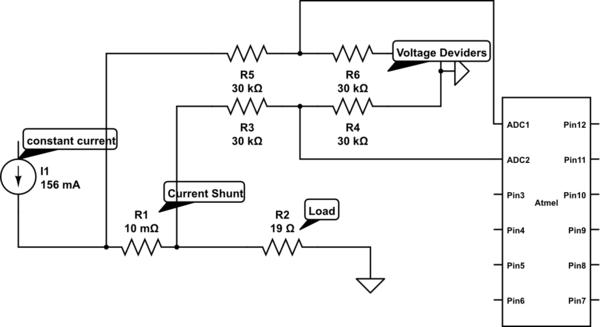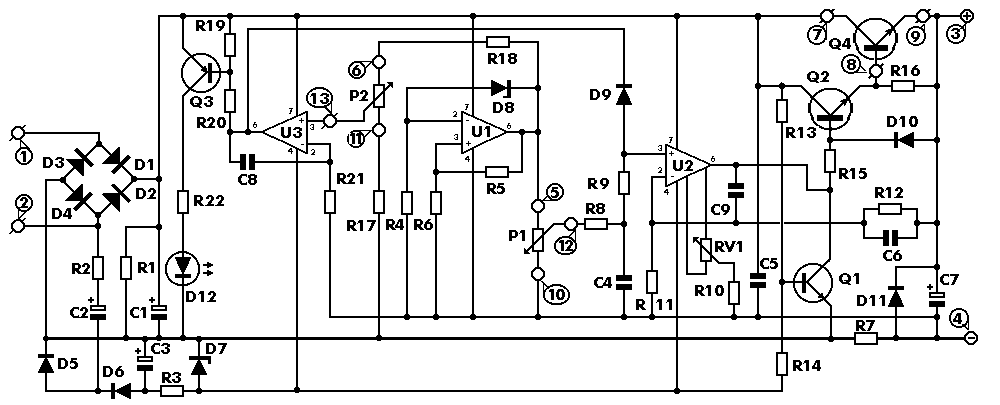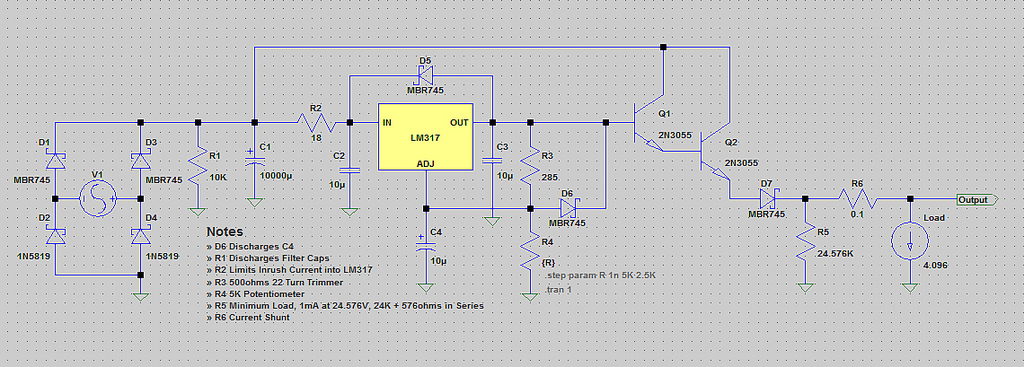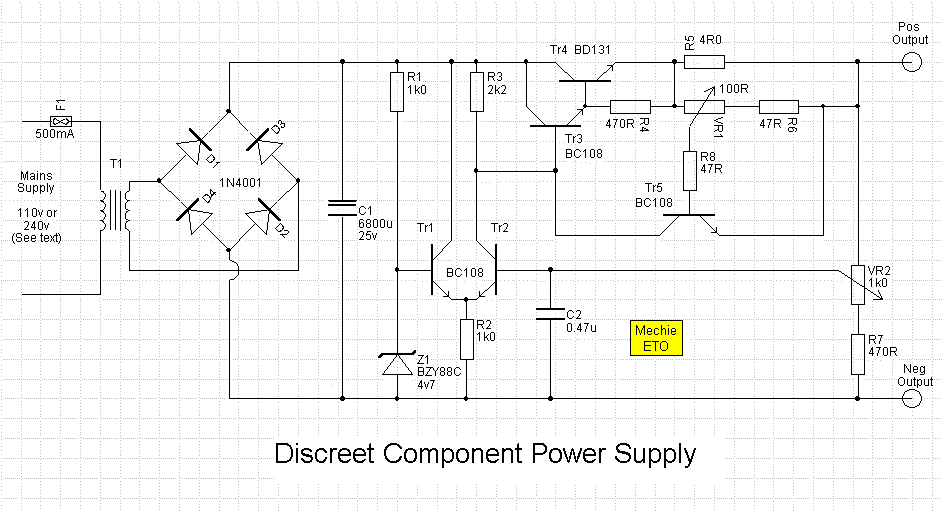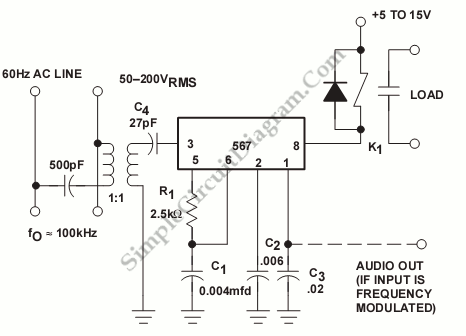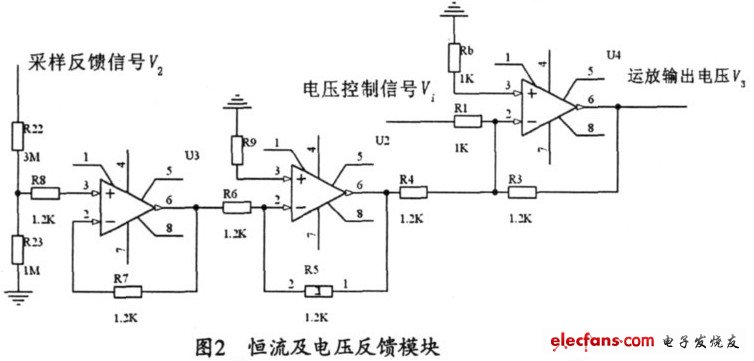
Fast Voltage-Driven Current Source
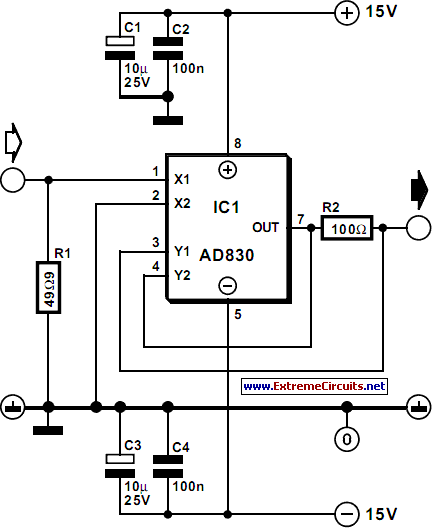
The current source in the diagram reacts very quickly to changes in the input signal and may be utilized in specific measurements. The differential amplifier IC1 ensures that the voltage across R2 is equal to the input voltage, represented by the equation Iout = Uin/R2. The bandwidth, B, is calculated using the formula B = R2 f / RL, where f is 80 MHz, and the load impedance RL is greater than or equal to R2 (both measured in ohms). The input is terminated with R1 to provide the standard 50-ohm impedance required by measuring instruments. Additionally, this resistor establishes the direct current (DC) operating point. If the connection to the driving signal source is short and DC-coupled, R1 may be omitted. The peak voltage between pins 1 and 2 of the IC is limited to 2.1 V to prevent excessive current at the output. Consequently, the peak output current is calculated as 2.1/100 = 21 mA.
The circuit described involves a current source that is highly responsive to input signal variations, making it suitable for precise measurements in electronic applications. The differential amplifier, designated as IC1, plays a crucial role in maintaining the voltage across resistor R2 at a level that corresponds directly to the input voltage. This relationship is essential for accurate current output, as defined by the equation Iout = Uin/R2, where Uin represents the input voltage.
The bandwidth of the system is a vital parameter, determined by the equation B = R2 f / RL. Here, R2 is the resistance in ohms, f is the frequency set at 80 MHz, and RL is the load impedance, which must be equal to or greater than R2 to ensure optimal performance. The circuit's design incorporates resistor R1, which serves a dual purpose: it provides the necessary 50-ohm termination for compatibility with measurement instruments and establishes the DC operating point of the circuit. In scenarios where the connection to the driving signal source is short and DC-coupled, the inclusion of R1 may be unnecessary, simplifying the circuit design.
To safeguard the integrity of the output current, the circuit limits the peak voltage between pins 1 and 2 of the differential amplifier IC to a maximum of 2.1 V. This limitation is critical in preventing excessive current flow that could potentially damage the circuit components. As a result, the maximum output current is calculated to be 21 mA, derived from the voltage limit divided by the resistance (2.1 V / 100 ohms). This current specification ensures that the circuit operates within safe parameters while providing the necessary response characteristics for high-speed measurements.The current source in the diagram, which react very fast to changes in the input signal, may be used, for instance, in certain measurements. Differential amplifier IC1 ensures that the potential across R2 is equal to the input voltage: Iout =Uin/R2.
The bandwidth, B, is given by B=R2 f /RL, where f=80 MHz, and the load impedance RL‰¥ R2 (both in ohms). The input is terminated into R1 to give the usual 50 impedance required by measuring instruments. At the same time, this resistor sets the d. c. operating point. If the link to the driving signal source is short and d. c. coupled, R1 may be omitted. The peak voltage between pins 1 and 2 of the IC is limited to 2. 1 V to prevent too large a current at the output. Therefore, the peak output current is 2. 1/100=21 mA. 🔗 External reference
The circuit described involves a current source that is highly responsive to input signal variations, making it suitable for precise measurements in electronic applications. The differential amplifier, designated as IC1, plays a crucial role in maintaining the voltage across resistor R2 at a level that corresponds directly to the input voltage. This relationship is essential for accurate current output, as defined by the equation Iout = Uin/R2, where Uin represents the input voltage.
The bandwidth of the system is a vital parameter, determined by the equation B = R2 f / RL. Here, R2 is the resistance in ohms, f is the frequency set at 80 MHz, and RL is the load impedance, which must be equal to or greater than R2 to ensure optimal performance. The circuit's design incorporates resistor R1, which serves a dual purpose: it provides the necessary 50-ohm termination for compatibility with measurement instruments and establishes the DC operating point of the circuit. In scenarios where the connection to the driving signal source is short and DC-coupled, the inclusion of R1 may be unnecessary, simplifying the circuit design.
To safeguard the integrity of the output current, the circuit limits the peak voltage between pins 1 and 2 of the differential amplifier IC to a maximum of 2.1 V. This limitation is critical in preventing excessive current flow that could potentially damage the circuit components. As a result, the maximum output current is calculated to be 21 mA, derived from the voltage limit divided by the resistance (2.1 V / 100 ohms). This current specification ensures that the circuit operates within safe parameters while providing the necessary response characteristics for high-speed measurements.The current source in the diagram, which react very fast to changes in the input signal, may be used, for instance, in certain measurements. Differential amplifier IC1 ensures that the potential across R2 is equal to the input voltage: Iout =Uin/R2.
The bandwidth, B, is given by B=R2 f /RL, where f=80 MHz, and the load impedance RL‰¥ R2 (both in ohms). The input is terminated into R1 to give the usual 50 impedance required by measuring instruments. At the same time, this resistor sets the d. c. operating point. If the link to the driving signal source is short and d. c. coupled, R1 may be omitted. The peak voltage between pins 1 and 2 of the IC is limited to 2. 1 V to prevent too large a current at the output. Therefore, the peak output current is 2. 1/100=21 mA. 🔗 External reference
